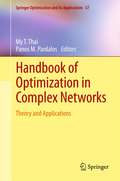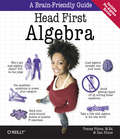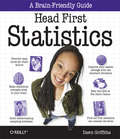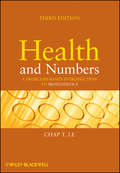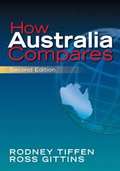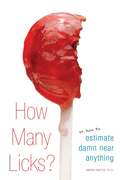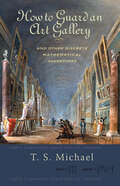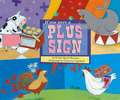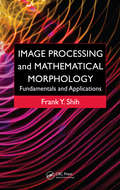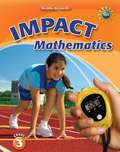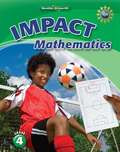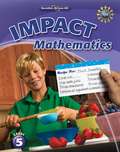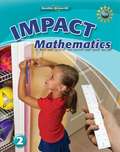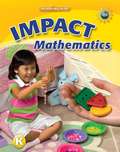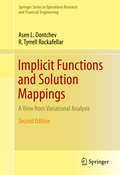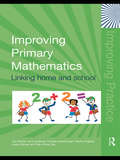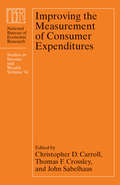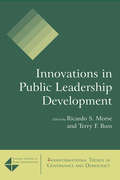- Table View
- List View
Handbook of Optimization in Complex Networks
by Panos M. Pardalos My T. ThaiComplex Social Networks is a newly emerging (hot) topic with applications in a variety of domains, such as communication networks, engineering networks, social networks, and biological networks. In the last decade, there has been an explosive growth of research on complex real-world networks, a theme that is becoming pervasive in many disciplines, ranging from mathematics and computer science to the social and biological sciences. Optimization of complex communication networks requires a deep understanding of the interplay between the dynamics of the physical network and the information dynamics within the network. Although there are a few books addressing social networks or complex networks, none of them has specially focused on the optimization perspective of studying these networks. This book provides the basic theory of complex networks with several new mathematical approaches and optimization techniques to design and analyze dynamic complex networks. A wide range of applications and optimization problems derived from research areas such as cellular and molecular chemistry, operations research, brain physiology, epidemiology, and ecology.
Head First Algebra: A Learner's Guide to Algebra I (Head First)
by Dan Pilone Tracey PiloneHaving trouble understanding algebra? Do algebraic concepts, equations, and logic just make your head spin? We have great news: Head First Algebra is designed for you. Full of engaging stories and practical, real-world explanations, this book will help you learn everything from natural numbers and exponents to solving systems of equations and graphing polynomials.Along the way, you'll go beyond solving hundreds of repetitive problems, and actually use what you learn to make real-life decisions. Does it make sense to buy two years of insurance on a car that depreciates as soon as you drive it off the lot? Can you really afford an XBox 360 and a new iPhone? Learn how to put algebra to work for you, and nail your class exams along the way.Your time is way too valuable to waste struggling with new concepts. Using the latest research in cognitive science and learning theory to craft a multi-sensory learning experience, Head First Algebra uses a visually rich format specifically designed to take advantage of the way your brain really works.
Head First Statistics: A Brain-Friendly Guide (Head First)
by Dawn GriffithsWouldn't it be great if there were a statistics book that made histograms, probability distributions, and chi square analysis more enjoyable than going to the dentist? Head First Statistics brings this typically dry subject to life, teaching you everything you want and need to know about statistics through engaging, interactive, and thought-provoking material, full of puzzles, stories, quizzes, visual aids, and real-world examples.Whether you're a student, a professional, or just curious about statistical analysis, Head First's brain-friendly formula helps you get a firm grasp of statistics so you can understand key points and actually use them. Learn to present data visually with charts and plots; discover the difference between taking the average with mean, median, and mode, and why it's important; learn how to calculate probability and expectation; and much more.Head First Statistics is ideal for high school and college students taking statistics and satisfies the requirements for passing the College Board's Advanced Placement (AP) Statistics Exam. With this book, you'll:Study the full range of topics covered in first-year statisticsTackle tough statistical concepts using Head First's dynamic, visually rich format proven to stimulate learning and help you retain knowledge Explore real-world scenarios, ranging from casino gambling to prescription drug testing, to bring statistical principles to lifeDiscover how to measure spread, calculate odds through probability, and understand the normal, binomial, geometric, and Poisson distributionsConduct sampling, use correlation and regression, do hypothesis testing, perform chi square analysis, and moreBefore you know it, you'll not only have mastered statistics, you'll also see how they work in the real world. Head First Statistics will help you pass your statistics course, and give you a firm understanding of the subject so you can apply the knowledge throughout your life.
Health and Numbers
by Chap T. LeLike its two successful previous editions, Health & Numbers: A Problems-Based Introduction to Biostatistics, Third Edition, is the only fully problems-based introduction to biostatistics and offers a concise introduction to basic statistical concepts and reasoning at a level suitable for a broad spectrum of students and professionals in medicine and the allied health fields. This book has always been meant for use by advanced students who have not previously had an introductory biostatistics course - material often presented in a one-semester course - or by busy professionals who need to learn the basics of biostatistics. This user-friendly resource features over 200 real-life examples and real data to discuss and teach fundamental statistical methods. The new edition offers even more exercises than the second edition, and features enhanced Microsoft Excel and SAS samples and examples. Health & Numbers, Third Edition, truly strikes a balance between principles and methods of calculation that is particularly useful for students in medicine and health-related fields who need to know biostatistics.
How Australia Compares
by Rodney Tiffen Ross GittinsHow Australia Compares is a handy reference that compares Australia with 17 other developed countries across a wide range of social, economic and political dimensions. Whenever possible, it gives not only snapshot comparisons from the present, but charts trends over recent decades or even longer. Encyclopaedic in scope, it provides statistics for a huge range of human activity, from taxation to traffic accidents, homicide rates to health expenditure, interest rates to internet usage. This new edition is fully revised and updated, and features two new chapters: The Howard Impact and The Search for Scoreboards. New sections include obesity, advertising, broadband internet access, childcare and corruption. Information is highly accessible with double-page spreads for each topic. Tables and graphs are presented on one page, and clear explanation and analysis on the facing page. In each discussion the focus is to put the Australian experience into international perspective, drawing out the implications for the nation's performance, policies and prospects.
How Likely is it? Understanding Probability
by Glenda Lappan James T. Fey William M. Fitzgerald Susan N. Friel Elizabeth Difanis PhillipsNIMAC-sourced textbook
How Many Licks?: Or, How to Estimate Damn Near Anything
by Aaron SantosHow many licks to the center of a Tootsie Pop? How many people are having sex at this moment? How long would it take a monkey on a typewriter to produce the plays of Shakespeare? For all those questions that keep you up at night, here's the way to answer them. And the beauty of it is that it's all approximate!Using Enrico Fermi's theory of approximation, Santos brings the world of numbers into perspective. For puzzle junkies and trivia fanatics, these 70 word puzzles will show the reader how to take a bit of information, add what they already know, and extrapolate an answer.Santos has done the impossible: make math and the multiple possibilities of numbers fun and informative. Can you really cry a river? Is it possible to dig your way out of jail with just a teaspoon and before your life sentence is up?Taking an academic subject and using it as the prism to view everyday off-the-wall questions as math problems to be solved is a natural step for the lovers of sudoku, cryptograms, word puzzles, and other thought-provoking games.
How to Guard an Art Gallery and Other Discrete Mathematical Adventures
by T.S. MichaelWhat is the maximum number of pizza slices one can get by making four straight cuts through a circular pizza? How does a computer determine the best set of pixels to represent a straight line on a computer screen? How many people at a minimum does it take to guard an art gallery?Discrete mathematics has the answer to these—and many other—questions of picking, choosing, and shuffling. T. S. Michael's gem of a book brings this vital but tough-to-teach subject to life using examples from real life and popular culture. Each chapter uses one problem—such as slicing a pizza—to detail key concepts about counting numbers and arranging finite sets. Michael takes a different perspective in tackling each of eight problems and explains them in differing degrees of generality, showing in the process how the same mathematical concepts appear in varied guises and contexts. In doing so, he imparts a broader understanding of the ideas underlying discrete mathematics and helps readers appreciate and understand mathematical thinking and discovery.This book explains the basic concepts of discrete mathematics and demonstrates how to apply them in largely nontechnical language. The explanations and formulas can be grasped with a basic understanding of linear equations.
How to Guard an Art Gallery: And Other Discrete Mathematical Adventures
by T.S. MichaelAn “accessible and engaging” tool for understanding the branch of mathematics that is so crucial to modern computer science, using real-life problems (Mathematical Reviews).What is the maximum number of pizza slices one can get by making four straight cuts through a circular pizza? How does a computer determine the best set of pixels to represent a straight line on a computer screen? How many people at a minimum does it take to guard an art gallery?Discrete mathematics has the answer to these—and many other—questions of picking, choosing, and shuffling. T. S. Michael’s gem of a book brings this vital but tough-to-teach subject to life using examples from the real world and popular culture. Each chapter uses one problem—such as slicing a pizza—to detail key concepts about counting numbers and arranging finite sets. Michael takes a different perspective in tackling each of eight problems and explains them in differing degrees of generality, showing in the process how the same mathematical concepts appear in varied guises and contexts. In doing so, he imparts a broader understanding of the ideas underlying discrete mathematics and helps readers appreciate and understand mathematical thinking and discovery.This book explains the basic concepts of discrete mathematics and demonstrates how to apply them in largely nontechnical language. The explanations and formulas can be grasped with a basic understanding of linear equations.
How to Think Like a Mathematician
by Kevin HoustonLooking for a head start in your undergraduate degree in mathematics? Maybe you've already started your degree and feel bewildered by the subject you previously loved? Don't panic! This friendly companion will ease your transition to real mathematical thinking. Working through the book you will develop an arsenal of techniques to help you unlock the meaning of definitions, theorems and proofs, solve problems, and write mathematics effectively. All the major methods of proof - direct method, cases, induction, contradiction and contrapositive - are featured. Concrete examples are used throughout, and you'll get plenty of practice on topics common to many courses such as divisors, Euclidean algorithms, modular arithmetic, equivalence relations, and injectivity and surjectivity of functions. The material has been tested by real students over many years so all the essentials are covered. With over 300 exercises to help you test your progress, you'll soon learn how to think like a mathematician.
If You Were A Plus Sign (Math Fun)
by Francesca Carabelli Trisha Speed ShaskanWhat could you do if you were a plus sign? You could add things together. You could add people and animals. You could add up and down or side to side. Discover even more answers in this installment of the bestselling MATH FUN series by Trisha Speed Shaskan! With creative examples, easy-to-understand text, and engaging art, these entertaining and educational picture books books are perfect for young math lovers to read aloud or read alone.
If You Were a Minus Sign (Math Fun)
by Francesca Carabelli Trisha Speed ShaskanWhat could you do if you were a minus sign? You could subtract one number from another. You could subtract food and balloons. In every problem, you would find the difference. Discover even more answers in this installment of the bestselling MATH FUN series by Trisha Speed Shaskan! With creative examples, easy-to-understand text, and engaging art, these entertaining and educational picture books books are perfect for young math lovers to read aloud or read alone.
Image Processing and Mathematical Morphology: Fundamentals and Applications
by Frank Y. ShihIn the development of digital multimedia, the importance and impact of image processing and mathematical morphology are well documented in areas ranging from automated vision detection and inspection to object recognition, image analysis and pattern recognition. Those working in these ever-evolving fields require a solid grasp of basic fundamentals, theory, and related applications—and few books can provide the unique tools for learning contained in this text. Image Processing and Mathematical Morphology: Fundamentals and Applications is a comprehensive, wide-ranging overview of morphological mechanisms and techniques and their relation to image processing. More than merely a tutorial on vital technical information, the book places this knowledge into a theoretical framework. This helps readers analyze key principles and architectures and then use the author’s novel ideas on implementation of advanced algorithms to formulate a practical and detailed plan to develop and foster their own ideas. The book: Presents the history and state-of-the-art techniques related to image morphological processing, with numerous practical examples Gives readers a clear tutorial on complex technology and other tools that rely on their intuition for a clear understanding of the subject Includes an updated bibliography and useful graphs and illustrations Examines several new algorithms in great detail so that readers can adapt them to derive their own solution approaches This invaluable reference helps readers assess and simplify problems and their essential requirements and complexities, giving them all the necessary data and methodology to master current theoretical developments and applications, as well as create new ones.
Impact Mathematics: Grade 3
by Frances Basich Whitney Robyn Silbey Jane D. Gawronski Viken HovsepianNIMAC-sourced textbook
Impact Mathematics: Grade 4
by Frances Basich Whitney Robyn Silbey Jane D. Gawronski Viken HovsepianNIMAC-sourced textbook
Impact Mathematics: Grade 5
by Frances Basich Whitney Robyn Silbey Jane D. Gawronski Viken HovsepianNIMAC-sourced textbook
Impact: Mathematics, Grade K
by Frances Basich Whitney Robyn Silbey Jane D. Gawronski Viken HovsepianNIMAC-sourced textbook
Implicit Functions and Solution Mappings
by R. Tyrrell Rockafellar Assen L. DontchevThe implicit function theorem is one of the most important theorems in analysis and its many variants are basic tools in partial differential equations and numerical analysis. This book treats the implicit function paradigm in the classical framework and beyond, focusing largely on properties of solution mappings of variational problems. The purpose of this self-contained work is to provide a reference on the topic and to provide a unified collection of a number of results which are currently scattered throughout the literature. The first chapter of the book treats the classical implicit function theorem in a way that will be useful for students and teachers of undergraduate calculus. The remaining part becomes gradually more advanced, and considers implicit mappings defined by relations other than equations, e.g., variational problems. Applications to numerical analysis and optimization are also provided. This valuable book is a major achievement and is sure to become a standard reference on the topic.
Improving Primary Mathematics: Linking Home and School (Improving Practice (TLRP))
by Jan Winter Martin Hughes Jane Andrews Pamela Greenhough Leida Salway Wan Ching YeeImproving Primary Mathematics provides primary teachers with practical ideas about how to bring these two worlds closer to improve children’s mathematics learning. Using a number of fascinating case studies focusing on children’s experiences of mathematics both inside and outside the classroom, the book asks: How do children use mathematics in their everyday lives? How can teachers use this knowledge to improve children’s learning in school? What activities can teachers use with parents to help share the ways that schools teach mathematics? What can parents do to support their children’s learning of mathematics? Tried-and-tested practical suggestions for activities to support and encourage children’s learning of mathematics include: making videos to share teaching methods; children taking photos to show how they use mathematics at home; inviting parents into school to share in mathematics learning; and numeracy-based activities for children and their parents to do together at home. All those involved in planning, teaching and supporting primary mathematics will benefit from new insights into how learning at home and at school can be brought together to strengthen and improve children’s learning of mathematics.
Improving the Measurement of Consumer Expenditures
by Thomas F. Crossley John Sabelhaus Christopher D. CarrollRobust and reliable measures of consumer expenditures are essential for analyzing aggregate economic activity and for measuring differences in household circumstances. Many countries, including the United States, are embarking on ambitious projects to redesign surveys of consumer expenditures, with the goal of better capturing economic heterogeneity. This is an appropriate time to examine the way consumer expenditures are currently measured, and the challenges and opportunities that alternative approaches might present. Improving the Measurement of Consumer Expenditures begins with a comprehensive review of current methodologies for collecting consumer expenditure data. Subsequent chapters highlight the range of different objectives that expenditure surveys may satisfy, compare the data available from consumer expenditure surveys with that available from other sources, and describe how the United States's current survey practices compare with those in other nations.
Improving the Measurement of Late-Life Disability in Population Surveys: Beyond ADLs and IADLs - Summary of a Workshop
by National Research Council of the National AcademiesImproving the Measurement of Late-Life Disability in Population Surveys summarizes a workshop organized to draw upon recent advances to improve the measurement of physical and cognitive disability in population surveys of the elderly population. The book questions whether or not the measures of activities of daily living and instrumental activities of daily living used in many population surveys are sufficient as the primary survey-based indicators of late-life disability. If not, should they be refined or should they be supplemented by other measures of disability in surveys? If yes, in what ways should disability measures be changed or modified to produce population estimates of late-life disability and to monitor trends? The book also discusses what further research is needed to advance this effort.
Innovations in Public Leadership Development (Transformational Trends In Governance And Democracy Ser.)
by Terry F. Buss Ricardo S. MorseThis is the best single-source guide to leadership development in the public sector. It offers a wealth of advice for teachers, students, trainers, human resource officers, and established leaders. The all-original chapters include discussions of leadership frameworks, competencies for public leaders for the "new governance," and strategies for senior leaders in government.The book's wide-ranging coverage includes in-depth discussions of specific approaches to learning methods such as action learning and social artistry, as well as presentations of leader development models such as transformational stewardship and global leadership. The contributors present experiences from real-world leadership development programs, and the book situates leader development within the current trends of networks, collaboration, and boundary-crossing work in the public sector.
Input-Output Analysis
by Ronald E. Miller Peter D. BlairThe new edition of Ronald Miller and Peter Blair's classic textbook is an essential reference for students and scholars in the input-output research and applications community. The book has been fully revised and updated to reflect important developments in the field since its original publication. New topics covered include SAMs (and extended input-output models) and their connection to input-output data, structural decomposition analysis (SDA), multiplier decompositions, identifying important coefficients, and international input-output models. A major new feature of this edition is that it is also supported by an accompanying website with solutions to all problems, wide-ranging real-world data sets, and appendices with further information for more advanced readers. Input-Output Analysis is an ideal introduction to the subject for advanced undergraduate and graduate students in a wide variety of fields, including economics, regional science, regional economics, city, regional and urban planning, environmental planning, public policy analysis, and public management.
International Migration in Cuba: Accumulation, Imperial Designs, and Transnational Social Fields
by Alejandro Portes Margarita Cervantes-RodríguezSince the arrival of the Spanish conquerors at the beginning of the colonial period, Cuba has been hugely influenced by international migration. Between 1791 and 1810, for instance, many French people migrated to Cuba in the wake of the purchase of Louisiana by the United States and turmoil in Saint-Domingue. Between 1847 and 1874, Cuba was the main recipient of Chinese indentured laborers in Latin America. During the nineteenth century as a whole, more Spanish people migrated to Cuba than anywhere else in the Americas, and hundreds of thousands of slaves were taken to the island. The first decades of the twentieth century saw large numbers of immigrants and temporary workers from various societies arrive in Cuba. And since the revolution of 1959, a continuous outflow of Cubans toward many countries has taken place—with lasting consequences.In this book, the most comprehensive study of international migration in Cuba ever undertaken, Margarita Cervantes-Rodríguez aims to elucidate the forces that have shaped international migration and the involvement of the migrants in transnational social fields since the beginning of the colonial period. Drawing on Fernand Braudel’s concept of longue durée, transnational studies, perspectives on power, and other theoretical frameworks, the author places her analysis in a much wider historical and theoretical perspective than has previously been applied to the study of international migration in Cuba, making this a work of substantial interest to social scientists as well as historians.
